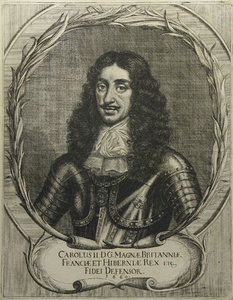| Method | Etching |
| Artist | after Pieter Nason |
| Published | c. 1670 |
| Dimensions | Image 290 x 226 mm, Plate 295 x 228 mm, Sheet 300 x 235 mm |
| Notes |
King Charles II (1630-1685), Reigned 1660-85, Charles's father, Charles I, was executed in 1649 and a republic, led by Oliver Cromwell, was declared in England. Charles fled to France in 1651 and remained in exile for nine years. After the Protectorate collapsed in 1659, Charles was invited to return to England and, with limitations on his powers, assumed the throne in 1660. This return of the monarchy is known as the Restoration. Charles II became adept at outmanoeuvring the opposition to his policies, particularly in matters of religion and foreign affairs. His court was notorious for its easy-going morality; he had fourteen children by various mistresses, but no legitimate heir. He converted to Roman Catholicism on his deathbed and was succeeded by his Catholic brother James. Pieter Nason (c.1612-1690) was a Dutch painter, likely a student of of Jan van Ravensteyn. He became a member of the Guild of Painters of The Hague in 1639, and a founding member of the Pictura Society in 1656. He is best known for his portraits of Charles the Second of England, engraved by C. Van Dalen and Sandrart and a portrait of Johan Maurits, Prince and Count of Nassau-Siegen, governor of Dutch Brazil, engraved by Houbraken. Ex. Col.: Hon. Christopher Lennox-Boyd. Condition: Trimmed to just outside platemark. |
| Framing | unmounted |
| Price | £150.00 |
| Stock ID | 24869 |

